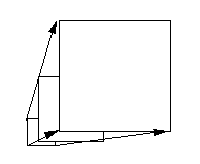|
|
How strong is the reflected radar pulse?
How bright a source looks depends not only on how much
energy it gives out but also upon how far away it is from the observer.
You know that lights look dimmer the farther away you are from them - the
same is true for any electromagnetic signal. This is because the energy
from any light wave as it
travels through space spreads out over a larger and larger surface area.
The further away you are from a source, the less light (or signal) there is
per unit area, and the less light you can collect with a "light bucket" of
a given area. This concept is illustrated in the diagram below:
 |
In this schematic, light rays traveling outwards from a source are
represented by arrows. You can see that the area (the squares) covered
by the light rays increases as the light extends from the source. The
same amount of light energy is spread out over more and more
area. The total area is proportional to the distance from the
source squared (think of the area of a sphere of radius R and how it
increases the larger R is; A = 4 pi R2). The intensity is
proportional to the distance squared. |
This effect can be expressed mathematically as:

In this formula, d is the distance the observer is from the source. If you
are 100 feet away from a 100 watt light bulb, it appears
four times dimmer than if you were fifty feet away.
|
